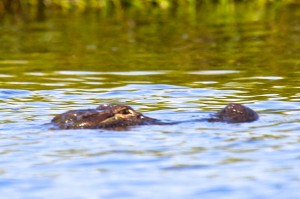I am amazed at how fearful most people are of alligators that are found here in the Wilmington NC area. This is one of the most common questions I get when I am leading a kayaking adventure. Yes, we should have a healthy respect and view these wonderful creatures from a safe distance. However it amazed how the fear keeps some people from exploring the majesty of God’s Creation just because they may encounter one of these animals. As a boy growing up in gator country of central Florida, you learned to understand the amazing creatures. So, like any good Boy Scout here are some facts about alligators that my help you know more about this magnificent creature, and be prepared on what to expect when you see one.

- The American Alligator is the most prevalent of the three species of crocodilians found in the US. The Gator’s range from North Carolina down to Florida and then around the Gulf Coast to Texas.
- There are very few American Crocodile and Caiman that can be found in the extreme southern part of Florida mainly in the southern portions of the Everglades.
- Gators live in freshwater wetlands and coastal brackish waters. Their diets mainly consist of fish, amphibians, reptiles, birds and mammals. They are more known for their savaging for food than hunting and attacking larger prey.
- Mating season beings in May as the spring warms up and the females will lay their eggs in June, with the eggs hatching in last July.
- Between 1948 – 2004 there were only 391 injuries and 18 deaths caused by alligators in the US.
- Alligators are active both day and night, but mainly feed at night and resting during the day light hours digesting their meal from the night before.
- Don’t let your pets swim in known waters where alligators live. The alligators will see the smaller pets at natural prey.
Dispose of fish scraps in garbage cans and throwing fish remains in the water can attract alligators. Also, do not feed alligators.
